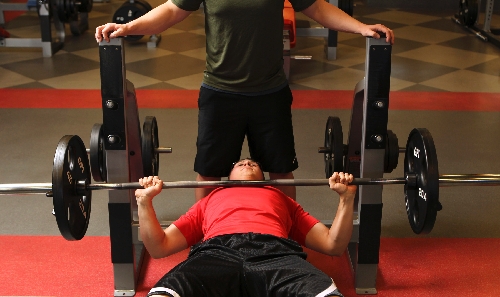If pecs are your exercise pick, be sure to use a spotter

It’s Monday, and you know what that means. It’s international chest day in the gym!
Guys tend to do their favorite routines on the first day of the week, and the bench press is ranked up there with arm and abs exercises. That’s why the benches are always busy and it’s hard to find the dumbbells you need.
Working the chest is serious business. When using free weights, use a spotter. No one will rank you lower on the macho scale if you have some trouble with the last rep of a set and need a helping hand. Consider the alternative – getting stuck lifting solo and having to cry out for help as the air is pushed out of your lungs from weight you were too weak to attempt. If no one comes to your aid, you have to dump the bar to one side and try an Indiana Jones escape from doom.
Here’s a quick anatomy lesson on the chest muscles. The chest is made up of two major muscles. The pectoralis major attaches at the upper arm bone and fans out from the clavicle, down the sternum and ends at the top of the abs. The pectoralis minor is the smaller pectoral muscle underneath the pectoralis major. It attaches from the shoulder to the upper ribs.
Chest exercises sometimes are seen as for guys only. That’s not true. Women also can benefit from working the pecs. Generally, most women don’t want a wide, heavily muscled torso. Doing chest presses serves to ensure the back and front of the body are evenly strong. Bad posture can be brought on by significant muscle imbalances.
Pectoral training for women probably will look different from pectoral training for men. A woman’s program will require her to perform more reps at a slower tempo to avoid building bulky muscles and to concentrate on tone. They may rely on dumbbell presses and pushups as the go-to exercises.
Men tend to use a program with fewer reps and a faster (yet still controlled) tempo to build muscles. They often favor dumbbells and barbells for their ability to add large amounts of weight.
It is not uncommon to strain a pectoral muscle during a workout. Strained and aching muscles are a part of exercising. Pec strains can be tricky to assess as well as pesky to rehabilitate.
They are tricky to assess because of where they attach; at the shoulder and the upper arm. A pec strain feels like an injured shoulder. So logically, if your shoulder hurts you lay off doing shoulder exercises for a while. Then the next time you do a chest workout, your shoulder hurts more. But it’s not really your shoulder that hurts. It’s the pec injury that wasn’t allowed to heal.
Rehabilitation is pesky because it takes time and many are concerned with losing strength during the break. Consider the alternative. Do you want to lose strength or have your pec tear, from which you’ll never be the same?
My recommendation is to take the break. Wait till the inflammation subsides, then massage and stretch until the range of motion returns to normal. As you get back into lifting, reassess your form to make sure you were exercising correctly.
Chris Huth is a Las Vegas trainer. You can contact him at 702trainer@gmail.com. Before beginning any exercise program, consult your physician.